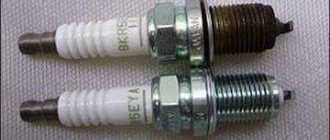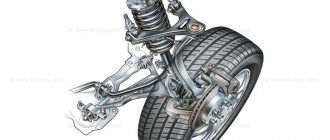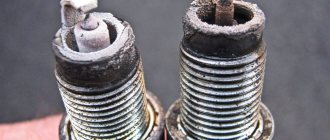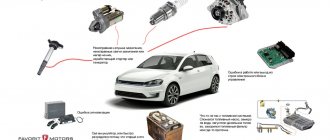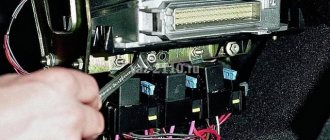A large number of motorists, while operating a vehicle, periodically encounter difficulties starting the power unit. In this case, quite often there are no obvious prerequisites in the form of clearly manifested malfunctions. An unexpected engine failure to start can occur both during a cold start and when trying to start a previously warmed-up internal combustion engine. In such cases, one of the most common reasons why a car engine does not start is that the spark plugs in the engine are filled with gasoline or oil.
We also recommend reading the article about why a hot engine won’t start. From this article you will learn why a warm gasoline engine with an injector and carburetor may not start, and why a diesel engine may not start when hot.
If the spark plugs on an injection engine or carburetor unit are flooded, starting the engine will be very difficult or completely impossible. This indicates the presence of certain problems both with the engine itself and with individual elements and systems. In this article we will talk about why spark plugs flood, how to understand why the spark plugs are flooded, and also what a driver should do if the car does not start, fill the spark plugs with gasoline or motor oil, etc.
What does “fills the candles” mean?
What does the term “drenched candles” mean? To understand this, let's first understand how everything works. A fuel-air mixture is supplied to the chamber of the internal combustion engine, which subsequently ignites. However, nothing like this will happen if the candles are already filled with liquids. That’s when the “lights out the candles” situation arises.
The cause of the problem lies in the flooding of the electrodes of the spark plugs. The more gasoline that gets in, the more difficult it is to ignite. In most cases this is impossible without thorough drying.
Drivers are more likely to encounter this situation during cold weather. In rainy autumn or frosty winter, the battery is heavily loaded. If the device fails, flooding of the candles is guaranteed.
For example, when you try to start a car several times, the spark plugs become even more filled with process fluid.
Pay attention to a number of reasons that indicate that engine oil has come into contact with the spark plugs:
- Reduced oil content in the crankcase;
- The engine does not start immediately;
- Problems with overclocking and power;
- The engine “troits” - one cylinder is inactive;
- Unstable at idle.
The listed points are signs of other problems arising too. Unscrew the spark plugs and inspect them: focus on the electrodes and insulators. You may find burnt oil or other critical aspects of the condition of the part.
Similar signs occur when coolant gets on machine parts. Additional troubles are characterized by a decrease in power and cooling mixture, as a result of which white soot appears on the spark plugs. A clear sign of this problem is white smoke coming from the exhaust pipe.
Studying plaque on candles
They say that when candles are “flooded,” black soot forms. Let us clarify: it should not consist of inclusions. All metal, in turn, will be covered with an oily coating. Dry carbon looks different...
Oily layer and dry soot
We recommend: Why does a gasoline engine smoke and what to do in this case?
The photo shows two cases. “Our version” is on the right.
And soot can also be brown. And it always, in 100% of cases, is formed due to flooding with gasoline.
Dark brown soot
An oily coating, as in photo 1, is, nevertheless, the result of oil ingress. But an oiled candle does not work correctly - it will also be “flooded”.
With regular “flooding,” carbon deposits form, which we see in photo 1 on the right and in photo 2. The rest does not apply to our case.
Causes of persistent problems
Process fluid is important in the operation of spark plugs. Let's consider several options that affect car parts in different ways.
Petrol
Three reasons why spark plugs are often filled with gasoline:
- The battery is often discharged in winter than in warmer periods of time. The device capacity is lost. When you try to start the engine, more and more gasoline sprays are observed. It seems to the driver that a spark is about to appear, but instead the situation only gets worse.
- Incorrect carburetor settings can cause big problems. Therefore, it is important to monitor this node from time to time, since the correct setting periodically fails. The cylinders are overfilled with fuel, which they do not have time to process. Such difficulties rarely arise in summer, but more often in winter.
In modern engines, the ECU controls the fuel supply. Reads information from sensors and acts based on the received data. At lower temperatures, fuel consumption increases. Starting and feeding depends on the serviceability of the devices. If something breaks, the candles are filled with the technological mixture.
Oil
A rare and dangerous situation. The cause is serious damage to engine parts. Engine oil passes through the rings or through a valve and ends up inside the cylinders.
The valve guides wear out and play occurs. From the cylinders, oil is directed into the combustion chamber and fills the spark plugs.
When the piston rings wear out, oil leaks into the combustion chamber. The rings finally become unusable when they burst. To find out about the current condition of the parts, check the compression.
Antifreeze
Let's consider the main reasons for flooding of spark plugs with antifreeze:
- The cylinder block overheats, gets damaged or its gasket becomes outdated.
- Geometry problems due to motor overheating. People say: “I lost my head.”
- The appearance of microcracks on the cylinder walls.
The engine does not start in cold weather, reasons
But flooding of spark plugs, unfortunately, is not the only factor that negatively affects the engine starting procedure at low temperatures. Every car owner should know about the most common of them - familiarity with the cause of problems of this kind often allows one to prevent the very possibility of their occurrence.
Problems with flooded spark plugs can occur when purchasing and installing a low-quality product. What we can recommend to car enthusiasts is that you should not choose consumables and spare parts for your car based on thoughts of maximum savings; purchasing a quality product at a higher price can often save you from many problems that arise during operation.
Flooding with gasoline can also occur due to a high degree of wear on the spark plugs.
A weak spark can also occur if the spark plugs are heavily contaminated with carbon deposits, but the spark produced from them is not able to ignite a cold fuel-air mixture that does not contain flammable vapors.
The solution is to timely clean the spark plugs from soot, and, if necessary, replace them with new ones of appropriate quality.
High-voltage wires are damaged, how to check and fix them
You can also fill the spark plugs with gasoline if the high-voltage wires are damaged. The reason is that faulty wiring can produce an uneven spark.
poor quality fuel
The quality of the fuel is a very important factor on which the evaporation process depends. Practice proves that even at normal temperatures some types of fuel do not exhibit normal combustion; there is no need to say that at subzero temperatures they will evaporate and ignite.
Experts recommend paying attention to the quality of the fuel your car is fueled with and its suitability for the season. For use in the cold season, you should give preference to gasoline with the maximum octane number allowed for your car engine.
A positive result can be obtained by using the winter type of gasoline offered in your region. Such fuel ignites much more easily, even in severe frosts.
malfunction of the power system, how to check and fix it
Difficulties in starting a cold engine can also be caused by faults in the power supply system. A negative impact is caused by clogged or worn injectors, which, as a result of existing defects, can supply the wrong amount of fuel. Naturally, such violations will cause the candles to burn out.
To eliminate the problem, it is recommended to systematically monitor the condition of the engine components and systems, and eliminate any deviations noticed in a timely manner. Maintaining the power system involves regular cleaning and adjustment to the recommended settings.
We should not forget about the need to properly charge the battery - otherwise it will supply a voltage that is insufficient to produce a spark at startup.
How to solve a problem
First, we determine the cause of the difficulties. Next, we will work out possible problem scenarios when...
Fills with gasoline
We bleed the cylinders for 10 seconds when opening the throttles. The goal is to get a lean mixture. Unscrew, clean and dry the candles. Check for gaps or other damage. We check the battery voltage with a multimeter.
Do not start the engine until the current problem has been resolved. Try this:
- After the third unsuccessful attempt, wait 10 minutes and try again.
- Be sure to charge the battery.
- Install spare spark plugs. Dry the filled parts and inspect the metal for possible damage.
- Start the engine only after the spark plugs have dried and the battery is fully charged.
Fills with oil
Can fill from above and below. When the insulator is flooded, immediately remove the grease with a syringe or paper. The problem is eliminated depending on the situation: the gasket is replaced or hermetically sealed.
With strong oil flows, it is illogical to move further. We fix the problem by replacing the seals, rings or valve guides.
It is wise to replace oil seals when the valve bushings are still in good condition. Because a new part will not change the situation. Then it is more logical to replace the guide bushings. If there is significant wear, the valves are also replaced.
Fills with antifreeze
The cause of this problem is a burnout of the cylinder head gasket and problems with the geometry of the “head”. Therefore, we replace materials and polish the surface.
In case of serious damage to the head, it is recommended to contact specialists from auto repair shops. The workshop staff will quickly restore the shape of the part. For this purpose, service technicians use professional machines.
Flooding when there is a spark and the starter is rotating
Experienced motorists are faced with situations when a spark appears, the starter rotates, but the lower part of the spark plugs is filled with gasoline. Do not be deluded by the presence of a fire, since this event can occur irregularly under pressure and can be lost while the engine is running.
The cause of the event appears to be excessive pressure in the cylinders. It will be possible to identify the event and the factors that motivate it by monitoring the car on a stand that simulates a combustion chamber.
We recommend paying attention to the valve timing, because their failure will be the cause of wet electrodes . In injection internal combustion engines, motorists should check the functionality of the bypass valve located on the fuel rail. If its malfunctions are ruled out, you will need to find out the gasoline pressure in the rail, because the manufacturer regulates this parameter. Sharp fluctuations and going beyond the specified interval (larger/smaller sides) can block the start of the internal combustion engine or stimulate flooding of contacts for spark ignition.
Diagnostics will need to be carried out for the sensors of the electronic control system and for the injectors. An example of a failure is when the coolant temperature sensor sends incorrect data. In such a situation, the control unit unreasonably over-enriches the fuel mixture. Much less often, the culprit of incorrect impulses is a failed electronic control unit or a malfunction of its software. In this case, problems will appear not only with the ignition.
Verdict
More often, difficulties haunt drivers when they use gasoline and have a dead battery. The spark does not ignite, and fuel fills the spark plugs more and more.
It is not recommended to continue driving in this case. There will be extra gasoline consumption and power indicators will decrease.
At the first sign, fix the problem immediately. An experienced driver always has spare spark plugs in the trunk.
Cold start problems
Troubles with ignition often occur in the cold season. If the car is stored open, a frosty morning can bring trouble to the car owner.
The problem can be identified by some indirect signs:
- There is rotation of the crankshaft by the starter, but there is no seizure;
- a distinct smell of gasoline spreads through the exhaust system, which is audible especially when the starter rotates;
- Having unscrewed the spark plugs, you can notice fuel residues not only on the electrodes, but also on the threads, and the underside is covered with dark soot.
It is important to know that the injector fills the spark plugs with gasoline in cold weather much less often than carburetor counterparts do.
There are certain features when filling spark plugs in a car with an injection power system and a carburetor, but in both cases the common feature is the presence of fuel entering the chamber and the absence of its ignition. In this case, the contacts end up in liquid, sparking does not occur, and further normal operation of the motor becomes impossible.
Photo of the correct diagnosis if the spark plugs are flooded
Prevention is the best way to prevent candles from flooding
To prevent the spark plugs from flooding, you need to maintain your car properly.
- charged battery;
- good condition of high-voltage wires;
- serviceable ignition coils;
- clean injector nozzles;
- MAP sensor or mass air flow sensor is working properly;
- clean fuel filter.
If your car regularly does not start
Because the spark plugs are flooded, the reason should be sought not in the spark plugs themselves, but in the computer, wiring or sensors.
In the event that the car is flooded with 1 or 2 spark plugs
, and the rest of the spark plugs are fine, the problem may be in the injectors which, due to their poor performance, are unable to fill the rest of the spark plugs or the computer.
It's better to warm up your car in winter
, having spent a liter of gasoline overnight, rather than unscrew flooded spark plugs in the cold, wasting your nerves and time.
Source
Dealing with the consequences
Let's figure out what to do if the candles are flooded. If the motorist is sure that this has happened, then it is worth drying them using one of the selected methods. Most operating instructions for cars with fuel injection systems recommend immediately unscrewing them from the socket with a spark plug wrench.
At the next stage, dry the engine by cranking the starter without spark plugs for about 10 seconds. After drying, we return the spark generators to their sockets and try to start in normal mode.
It is allowed to start the engine with the spark plugs filled with the option of purging the cylinders. In many situations, this option will make it possible to start the power plant without additional removal of parts. Purge of cylinders in injection engines will be carried out by fully pressing the accelerator pedal during startup and cranking the starter for 10 seconds. Next, release the pedal and try to start normally.
It is important to understand that by pressing the gas pedal during purging, the driver opens the throttle valve as much as possible, which stimulates maximum air penetration into the cylinders and ensures drying of wet surfaces.
Even after purging, the engine may not start in some cases. Then you will have to dry the candles by first unscrewing them and cleaning them from carbon deposits in advance. You will need a medium hard brush. To remove moisture, a hair dryer or oven is suitable, after which check the gap between the electrodes.
After such operations, it is worth purchasing a new set of spark plugs, since the service life of the old ones is significantly reduced after calcination. Replacement is usually carried out after 15–25 thousand kilometers, regardless of the external condition . With frequent filling, it is necessary to get rid of the cause that causes it, and not the consequences.
Cause of faulty spark plugs
Floods candles, most often during cold weather. Especially noticeable in late autumn. Sometimes it is possible to start the engine, but it runs erratically and for a short period of time. When you try to accelerate it (press the gas pedal), it stalls for a second and a sharp bang is heard in the exhaust pipe. This phenomenon is dangerous, as it can disrupt the ignition timing.
The first thing the driver does in this case is check the color of the spark plugs. The threads and electrodes are in most cases covered with black carbon and are too wet - all this means that the spark plugs are flooded.
In this case, it does not depend on what type of engine you have (injection or carburetor), the problem manifests itself equally in both engines. To determine the source of the problem, you need to understand how the engine starts.
The process of starting the engine is as follows: the starter spins the crankshaft flywheel and sets in motion all the important organs of the engine. These include the camshaft, valves, and at the same time, spark production begins at the ends of the spark plugs. At this time, the gasoline pump pumps a mixture of gasoline and air, which enters the combustion chamber. At the moment fuel is supplied to the chamber, a spark is formed on the electrodes of the spark plug (at the correct ignition timing), which ignites the mixture and creates a small explosion, which, in turn, moves the piston inside the cylinder.
It becomes clear that if a spark does not appear, then the mixture simply floods the spark plug, which is no longer able to produce a spark. Ultimately, it becomes covered with a layer of soot, and the remains of unburned gasoline explode in the exhaust pipe, creating an unpleasant sound that many car enthusiasts are so afraid of. This phenomenon is associated with a malfunction of the spark plugs, so before looking for the problem in other places, you should check for the presence of a spark. To do this you need to use a special gun.
What are they doing to prevent this from happening?
The most important thing in this case is to ensure the proper technical condition of the engine systems
First of all, pay attention to the condition of the battery. Topping up with distilled water doesn't end there.
It should be charged and the charge level checked regularly. For areas with low temperatures in winter, the use of insulated battery covers is recommended. They can be purchased at automotive stores or made yourself. In very severe frosts, it is best to remove the battery from the car and bring it into a warm room.
Battery cover to keep the battery charged in cold weather.
The starter must be in perfect condition. If there are problems in it, then even with a fully charged battery it is impossible to start the engine. The battery's energy will be taken by a faulty starter, so it will not be enough to produce a high-quality spark.
On used injection engines, you need to regularly clean the injectors. Experts do not recommend performing surgery using additives added to gasoline. The desired effect is obtained after using the appropriate equipment, which some craftsmen make themselves.
Finally, I would like to give advice from experienced drivers. Periodically clean the spark plugs by driving at high speeds. It is enough to drive a certain distance at a speed of 110-120 km/h for self-cleaning to occur.
What are candles
Let's look at the device so that you can understand more clearly what we are dealing with:
- The spark plug housing is screwed into the cylinder head
- The insulator material in it is heavy-duty technical ceramics
- From the inside, a central electrode is fixed on one side and a contact rod on the other in the ceramic part of the spark plug.
- And between them there can be a resistor that suppresses radio interference
- Its side electrode is welded to the body
The design differences between the spark plug insulator and the central electrode itself make it possible to divide them into hot or cold:
- Hot candles are distinguished by a large surface of the insulator, which protrudes into the chamber and is heated by burning gases, and the transition zone from the insulator to the outer shell, on the contrary, is small
- Cold ones have an increased heat removal zone, so their working surfaces heat up less
- The heat number expresses the ability to accumulate heat
- Therefore, in order to choose the right replacement spark plug, you need to use an interchangeability table or a proprietary catalog, because the manufacturer has its own catalog system
Oil problems
The spark plug contacts can be filled with not only fuel, but also oil. The facts are found on both carburetor and injection engines. It may fail on one or more cylinders.
When filling candles with oil, the first thing you need to do is determine whether the filling is happening from below or from above. This is noticeable by which part of the candle is more dirty. If lubricant accumulates inside the spark plug well, it is necessary to check the tightness of the cover valve gasket, as well as the adjacent seals.
If there is visible black carbon deposits on the unscrewed spark plug in the thread area, then the oil is penetrating from the well. Accordingly, filling is carried out from below. It will be necessary to measure compression in the cylinders, because the chance of oil ring failure increases significantly. The following events can happen to them:
- a crack has appeared;
- occurrence occurred;
- wear of the mating surfaces has occurred.
It can also be caused by wear of the liner or cylinder block wall. Additionally, we recommend checking the condition of the valve guides, valve stem seals, and possible cracks in the cylinder head through which lubricant penetrates.

